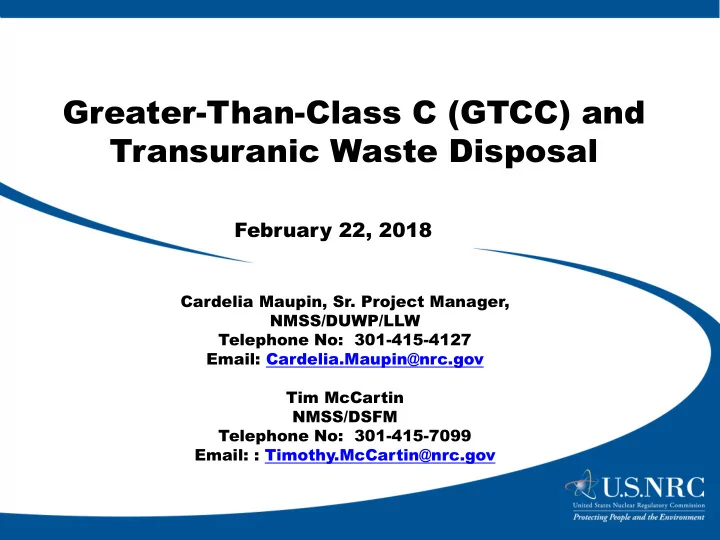

Greater-Than-Class C (GTCC) and Transuranic Waste Disposal February 22, 2018 Cardelia Maupin, Sr. Project Manager, NMSS/DUWP/LLW Telephone No: 301-415-4127 Email: Cardelia.Maupin@nrc.gov Tim McCartin NMSS/DSFM Telephone No: 301-415-7099 Email: : Timothy.McCartin@nrc.gov
Purpose of Meeting • Stakeholder participation and involvement • Identification of various technical issues • Assist in the development of a regulatory basis for the disposal of GTCC and TRU wastes • Supports NRC’s openness strategies and cumulative effects of regulation initiatives 2
Low-Level Waste (LLW) and Transuranic Waste LLW Trans- uranic Class Class Waste B A Class GTCC C 3
Regulatory Basis for GTCC and Transuranic Wastes • SECY-15-0094 – Texas request for clarification on Agreement State authority to regulate GTCC • SRM-SECY-15-0094 - prepare a regulatory basis for the disposal of GTCC waste through means other than deep geologic disposal • Address transuranic waste in 10 CFR 61.2 “Definitions” • SRM-SECY-16-0106 – due 6 months after publication of Part 61 supplemental proposed rule 4
Next Steps Potential Part 61 Prepare Rule for Regulatory GTCC and Complete Basis with Transuranic Part 61 Public Waste Supplemental Workshops Disposal Proposed Rule 5
Draft Technical Analysis • Assist in the identification of potential hazards, for example inventories o security o • Assist public to respond to NRC staff questions 6
GTCC Waste Three categories of GTCC waste: • activated metals, sealed sources, and other waste Reactor Sealed Glove Boxes Vessels Sources 7
Activated Metals • Metal components from nuclear reactors are most significant source • Surface contamination on metal surfaces • Activated radionuclides throughout metal • Short-lived radionuclides generate heat • Some transuranic radionuclides present in surface contamination 8
Sealed Sources • Irradiators typically used in medical applications (e.g., hospitals, universities, research) o short lived sources (Cs-137 – 30 year half-life) o transuranic radionuclides (e.g., Pu isotopes) • Fissile radionuclides present (Pu-239) • Short-lived radionuclides generate heat 9
‘Other’ Waste • Variety of potential sources, for example: o potential exhumation of West Valley waste o production of radioisotopes for nuclear imaging procedures (e.g., Mo-99 production) • Fissile radionuclides present from Mo-99 production (e.g., Pu-239) 10
GTCC Technical Considerations • Thermal Output • Gas Generation • Fissile Material • Long-lived Daughter (Progeny) 11
Radionuclides of Potential Interest based on Draft Analysis (depends on analysis assumptions) Hazard Activated Metals Sealed Sources Other Waste (Commercial Reactors) (Mo-99 Production) 500 yrs 5,000 yrs 500 yrs 5,000 yrs 500 yrs 5,000 yrs Off-site Dose Pu-239 Pu-239 Am-241, Pu-239, Pu-239 Pu-239 Pu-239 Am-241 Cs-137 Ni-63 None Am-241 None None None Thermal Output None None Pu-239 Pu-239 U-235 U-235 Fissile Material Ni-63 None Am-241 None None None Gas Generation C-14, Ni-59, C-14, Ni-59, Am-241 Pu-239 Pu-238, Pu-239, Pu-238, Intruder Dose Nb-94, Ni-63 Nb-94, Ni-63 Pu-240, Am-241 Pu-240 (shallow) Intruder Dose None None Am-241 Pu-239 None None (deep) 12
Three Questions 1) What are the important radionuclides that need to be considered for the disposal of the GTCC and transuranic wastes? 2) How might GTCC and transuranic wastes affect the safety and security of a disposal facility during operations (i.e., pre-closure period)? 3) How might GTCC and transuranic wastes affect disposal facility design for post-closure safety including protection of an inadvertent intruder? 13
Stakeholder Outreach and Involvement • Updated information on GTCC and transuranic wastes found on NRC Website: https://www.nrc.gov/waste/llw-disposal/llw-pa/gtcc- transuranic-waste-disposal.html • Federal Register Notice to Conduct GTCC and Transuranic Waste Scoping Meeting and Request for Comment (83 FR 6475): Feb. 14, 2018 14
How to Provide Comments • Federal Register notice (83 FR 6475) provides various methods of submitting comments: – Federal Rulemaking Website: Go to http://www.regulations.gov and search for Docket ID NRC-2017-0081 – Email comments: Rulemaking.Comments@nrc.gov – Fax comments: 301-415-1101 – Mail comments to: Secretary, U.S. Nuclear Regulatory Commission, Washington, DC 20555-0001, ATTN: Rulemakings and Adjudications Staff – Hand deliver comments: 11555 Rockville Pike, Rockville, Maryland 20852, between 7:30 a.m. and 4:15 p.m. (EST) Federal workdays; telephone: 301-415-1677. Comment period ends April 16, 2018 15
For Additional Information: • Federal Rulemaking Website: Go to http://www.regulations and search for Docket ID NRC-2017-0081 • NRC’s Public Web Site for GTCChttps: https://www.nrc.gov/waste/llw-disposal/llw-pa/gtcc- transuranic-waste-disposal.html • NRC Contacts: Cardelia Maupin – Sr. Project Manager 301-415-4127; Cardelia.Maupin@nrc.gov 16
Questions? 17
Recommend
More recommend